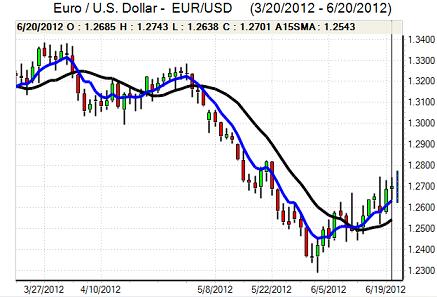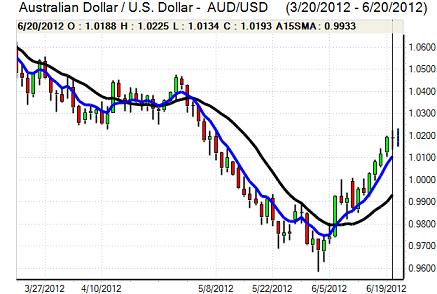EUR/USD
The Euro nudged higher in Europe ahead of the Federal Reserve meeting on Wednesday with hopes that there would be further supportive measures.
Following overnight reports in some media outlets that direct purchases of bonds could be considered through the EFSF/ESM mechanism German officials continued to deny that this was realistic. Chancellor Merkel did admit that it could be a theoretical possibility which maintained some market optimism over a shift in policies.
There was still a high degree of uncertainty surrounding Euro-zone policies which undermined longer-term confidence, especially with deteriorating confidence surrounding Italy and Spain.
The initial audit of Spain’s banking sector is due to be presented on Thursday with a provisional estimate of fresh capital required and this is likely to trigger a formal Spanish government request for aid. There were margin increase for trading Spanish and Italian bonds even though there was a sharp decline in benchmark yields during the day. There was also further evidence of underlying money-market stresses as dollar borrowing from the ECB increased.
There was agreement to form a coalition government in Greece, heading by New Democracy Leader Samaras. There was, however, a marked reluctance of coalition backers to formally enter government as they rejected cabinet posts and the proposed Finance Minister was non-political which did not suggest much in the way of confidence surrounding the government outlook or the possibility of securing major concessions.
The Federal Reserve announced no change in interest rates at the latest FOMC meeting. There was also no move to launch a third round of quantitative easing, but the Operation Twist was extended until the end of 2012 with the Fed continuing to buy longer-dated securities while selling shorter dates to keep long-term interest rates down. There was an 11-1 vote as regional President Lacker dissented.
The Euro dipped sharply following the announcement before reversing all the losses in choppy trading following Merkel’s comments. The Fed also cut its growth forecasts with the 2012 estimate lowered by 0.50% and Fed Chairman Bernanke insisted that all policy options were open. The Euro eventually settled weaker on the day in very choppy conditions with expectations that the Fed will act if necessary still important in holding back the US currency.

Source: VantagePoint Intermarket Analysis Software
Call now and you will be provided with FREE recent forecasts
that are up to 86% accurate* 800-732-5407
If you would rather have the recent forecasts sent to you, please go here
Yen
The dollar found initial support below 79 against the yen on Wednesday and pushed to highs close to 79.50 ahead of the Fed rate decision.
The decision not to expand quantitative easing provided initial support to the dollar and there was also a reduction in yen demand as equity markets rallied after an initial spike lower.
From a longer-term perspective, there was a further lack of confidence in the Japanese fundamentals which curbed yen demand to some extent and the yen was unable to make any headway in Asia on Thursday despite a slide in China’s HSBC PMI index to a nine-month low.
Sterling
Sterling dipped weaker ahead of the UK economic releases on Wednesday and the latest claimant count unemployment data was weaker than expected with an increase of 8,100 for May after a revised 12,800 decline the previous month. The net data was, however, slightly more encouraging with a small decline in the labour-force unemployment total.
The Bank of England left interest rates on hold at 0.50% following the latest monetary policy meeting, although there had been some discussion over whether to cut rates from the record low of 0.50% to help lessen upward pressure on market rates.
There was a close 5-4 vote for the amount of quantitative easing to be left on hold at GBP325bn as three members, including Governor King, voted for a GBP50bn extension to bond purchases while Fisher vote for an additional GBP25bn. The quantitative easing vote will increase speculation that the MPC will vote for additional quantitative easing at July’s meeting.
Sterling initially fell sharply following the minutes before recovering rapidly with a peak above 1.5770 and then trading erratically, broadly tracking wider US currency moves with a retreat back to below 1.57 as the Euro secured a small advance.
Swiss franc
The dollar found support on dips towards 0.9425 against the franc on Wednesday, but was unable to break back above 0.95 while the Euro was again trapped close to 1.2010. There were persistent fears that Spanish and Italian vulnerability would trigger defensive inflows into the Swiss franc.
The latest Swiss ZEW business confidence survey recorded a very sharp decline to -43.4 for June from -4 previously, increasing fears over a sharp economic slowdown and the data will also maintain pressure on the National Bank to preserve competitiveness by resisting franc gains.

Source: VantagePoint Intermarket Analysis Software
Call now and you will be provided with FREE recent forecasts
that are up to 86% accurate* 800-732-5407
If you would rather have the recent forecasts sent to you, please go here
Australian dollar
The Australian dollar hit resistance above the 1.02 level against the US currency on Wednesday and initially retreated sharply following the Federal Reserve interest rate decision before rallying equally quickly as equity markets rebounded. The currency eventually had small net losses in very choppy trading conditions.
The currency drifted weaker on Thursday with further doubts surrounding the Asian economic outlook with weakness in commodity prices also a key factor.



